Everything About Baking Stories and Bakers
There’s nothing in the world like the inviting smell of freshly baked goods wafting out of your favourite bakery entrance. But have you ever wondered what baking stories lie beyond those doors? Let’s take a look at a few stories and specific bakers who will provide you a wonderful glimpse behind the scenes. Of course, we could never forget to include the tale of how one baker survived the Titanic using a rather unconventional method!
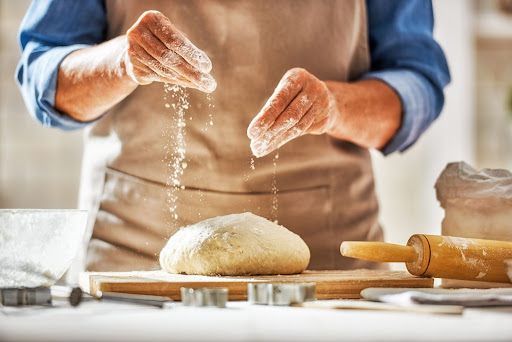
A Brief History of Baking
The origins of baking go back to Australian Aboriginal Peoples and Torres Strait Islander Peoples in the Paleolithic Era (30,000 years ago), and their use of grinding stones. This is the first account of baking, making them the world’s first bakers. By 8,000 BC, Egyptians started farming and yeast was used. By around 6,700 BC, maize was domesticated. However, it was in Ancient Rome that baking was created as a profession. Specialized places designed for baking began to appear, and the profession flourished. Roman artisans used honey and oil in their products, creating not only breads, but also pastries and delicacies.

A brief baking history timeline
By the 18th century, Europeans discovered methods to grow sugar locally. This led to the creation of even more pastry products and baking methods, such as puff pastry. The most groundbreaking innovations arrived with the Industrial Revolution in the 19th century in the form of cake mixes, allowing for quick and easy baking solutions. Thanks to new technology, ingredients became cheaper, which meant bakeries could produce larger quantities and experiment with new recipes and methods. And this industry, like many others, soared.
Special Baking Stories
Baking might seem straightforward, but that is not necessarily the truth! History is full of unbelievable baking stories that will add a touch of mystique to the bakers around the world, or the complexity of creating good recipes. Let’s jump into these anecdotes.
The 20-Year Mystery of Dublin’s Mary Cake Recipe
There is a well-known bakery in Dublin, Ireland named Bewley’s Café. In 1956, it added a new cake to its repertoire, named the Mary Cake. Consisting of chocolate filling on top of a sponge base, this cake was fully encased in chocolate and topped with a disc of marzipan. The Mary Cake was a huge success and eventually became a staple of Bewley’s café. However, during renovations, the recipe was lost. Bakers in Dublin tried hard to recreate the Mary Cake from memory and through trial and error, but nothing even came close to the original. It was feared that this classic dessert would be gone forever. But then something incredible happened.
With a bit of research, the current café owners learned that the recipe actually had originally come from abroad. A Hungarian baker named Henry Spelter, fled his country during the Hungarian uprising of 1956, and settled in Ireland. There, he was offered training and employment by Bewley’s Café. Later on, in their spare time, Mr. Spelter and his great uncle, Alfred, invented the Mary Cake based on a traditional Hungarian dessert and adapted to Irish tastes.
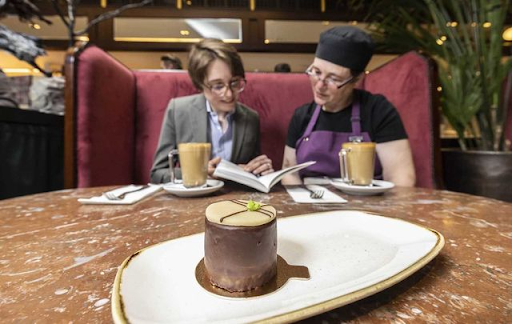
Carolina Malagon (right) and Hazel Carmichael (left) working together to research the recipe of the Dublin’s Mary Cake (Conor McCabe)
Through the internet, Hazel Carmichael, a food detective and granddaughter of the Bewley’s Café’s owner, managed to find Henry Spelter’s granddaughter, Carolina Malagon, who lives in New York. Hazel learned that Mr. Spelter had emigrated to the US and recently passed away, at the age of 95 (i.e., she found his obituary). Hazel first left Carolina a message of condolence for her grandfather. Carolina was intrigued almost instantly and they began discussing this famous cake. At some point, they agreed to meet in Dublin in an effort to relaunch the mysterious Mary Cake.
After much research, they stumbled upon a curious old ledger from Bewley’s Café. On it was a list of ingredients the café had ordered; ingredients that would serve to make, you guessed it, the Mary Cake! Carolina and Hazel noticed that the recipe replaced the original Hungarian cream with butter, and added more chocolate than the traditional Hungarian recipe. Thanks to these two perseverant granddaughters, the recipe was found, and the Mary Cake was reborn!
Today, the cakes are sold in aid of the Irish Red Cross, with a portion of their profit currently going to support Ukrainian refugees arriving in Ireland.
Video of the fabled Mary Cake is brought back to life in Bewley’s Cafe (The Irish Independent)
The Baker That Survived the Titanic
We’re sure you did not expect to read such a thing, but bear with us. The Titanic sank on April 14, 1912. It was one of the world’s deadliest maritime disasters; 1,500 people died in the frigid cold. Among the few survivors was the ship’s baker, Charles Joughin, who used an accidental and rather unorthodox survival method.
When it was clear that the ship was sinking, Joughin’s first reflex was to get spectacularly drunk. As frantic passengers were jumping into lifeboats, the baker decided to stay on board and ride the ship’s stern for as long as possible, until it sunk into Newfoundland’s cold waters. At that point, Joughin swam around for a couple of hours and found a lifeboat to crawl onto. His hair stayed dry the entire time and he didn’t even get frostbite!
Ironically, he had done everything one is supposed to do in this situation, without knowing it. To start, he delayed the moment of getting into the water as long as possible. By clinging to the stern, he was in fact the very last passenger to get off the ship! Next, all the alcohol he had consumed calmed him down and stopped him from panicking. Panic and hyperventilation reduces clarity and chance of survival. This gave Joughin enough calm and confidence to swim around until he found a lifeboat. Of course, this is not to try at home, and we hope you never get into this kind of situation! But we must salute this baker for his calm-headedness and crafty methods.
If you happen to (re)watch the 1953 or 1997 film, Titanic, you’ll see that Joughin even makes appearances, and his portrayals definitely do justice to the real story.
Charles Joughin on the Titanic Movie, 1953 (Youtube)
A Revival of Native Australian Baking Methods
Recently, historians in Australia have unearthed fascinating knowledge on ancient aboriginal agricultural practices. In fact, some even say that Australian Aboriginal peoples and Torres Strait Islander peoples were the world’s first bakers, which new archaeological finds can attest to. For example, in the 1990s, a grinding stone used to make flour was discovered in New South Wales and was estimated to be over 30,000 years old. In 2015, another grinding stone was discovered in the country which led to speculation showing that the first descendants from Africa have made their way to Australia with similar tools back in 65,000 BC!
Not only that, but the value in these indigenous baking methods is finally beginning to gain appreciation. Some grasses and other plants traditionally used (e.g. wattleseed, native millet) were typically considered weeds by other cultures and avoided. However, it has recently been discovered that these plants may come in handy in the next few years to produce sustainable food. Indeed, these specific plants are very heat and drought-resistant. Considering not only the droughts that Australia has gone through these last few years, but also other countries that experienced difficulties with crop growing, these native Australian plants might make a world of difference in bakers’ lives.
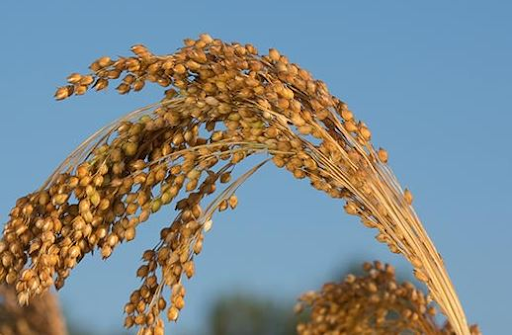
Native Millet (Grain Central)
We haven’t even mentioned yet all the health and taste benefits these plants offer. For example, agricultural scientist Angela Pattison has said that “the native millet was the easiest to grow, harvest and turn into flour, and it’s significantly more nutritious than wheat. It’s also high in fibre and gluten free. And it tastes good. It just ticks so many boxes.”
One of Italy’s Top Panettone is Made in an Italian Prison
The panettone is one of Italy’s most famous desserts/breads. You can find big boxes of panettones in most stores around Christmas time. And thanks to Dessert Advisor, finding the panettones in Canada has never been so easy! However, did you know that one of Italy’s most celebrated panettones also has interesting baking stories?
In 2005, an Italian bakery shop, Pasticceria Giotto, had an idea for a social project. They decided to move inside the Due Palazzi prison in Padua, Italy, to work side by side with the incarcerated people there. This program was designed to help the people of this prison earn a salary, to give them a sense of purpose, and eventually to integrate them back into society. Before hiring, the bakery interviewed based on many different criteria, and had the candidates evaluated by a psychologist. The criteria included, for example, whether they needed to support their family, the length of their sentences, and their personal profiles.
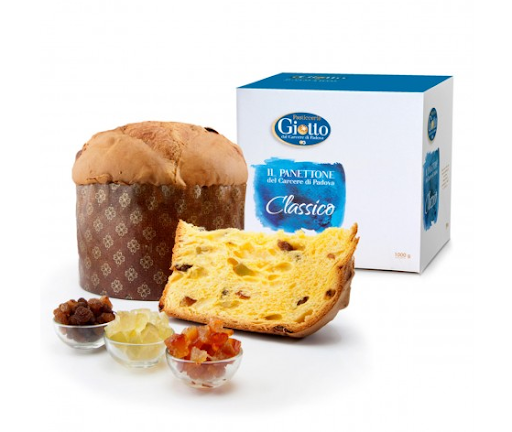
Panettone (Pasticceria Giotto)
Of the 500 incarcerated people of the prison, a few dozen were hired by this program. During their baking work, they were supervised by chefs and trained in the art of pastry-making. These employees produced artisanal cookies, pies, nougats, holiday cakes, and more. Of course, among the various confectioneries they baked, they eventually learned how to make panettones. Little did anyone know how well these cakes would turn out!
A panettone takes three days to make, as it requires extensive kneading and leavening. However, this work is not in vain. As they were sold across town, the panettone became a huge success! Even today, this cake baked in prison regularly comes up on lists of Italy’s top 10 panettones. Who could have predicted this? It just goes to show how with the right belief and guidance, there can always be hope for a second chance at life. In fact, the employees at the Due Palazzi prison have much work ahead of them. Last holiday season, this bakery produced an estimated tens of thousands of these special panettones, and will probably bake many more this coming year!
Google Uses Artificial Intelligence to Create Two New Mashup Desserts Based on Baking Search Data
Artificial intelligence is a great tool for improving technologies we use in our daily lives – as long as it doesn’t end up being used for a Terminator-like scenario, of course! Have no fear, AI can have many non-dystopian and fun uses. Recently Google found out it can even produce original, creative, and futuristic dessert recipes!
As internet searches for baking recipes spiked during the pandemic, some Google employees wanted to explore the science behind different pastry types: cakes, breads and cookies. What exactly makes cookies crunchy, cakes spongy, and breads fluffy? To find out, these people ran a machine learning program, AutoML Tables, through 700 cookies, cakes, and bread recipes. They standardized the measurements of each recipe and categorized each dessert type as precisely as possible. By doing this, the AI program learned what exactly makes a cookie, a bread, and a cake, based on the ingredients. Lo and behold, the program managed to isolate the ingredients that give each dessert its characteristic aspects, such as fluffiness, crispness or fudginess.
Afterwards, they decided to see if AI could come up with completely new dessert types by mixing specific attributes of these respective pastries. What would happen if this program made a recipe that was 50% cake and 50% cookie, for example?
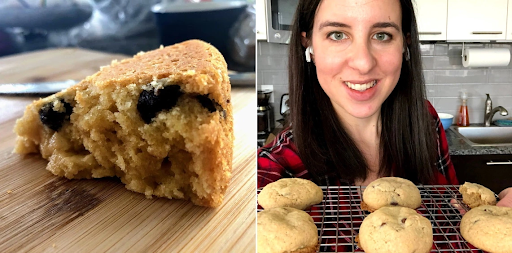
A cakie, left, and breakies, right, with Sarah Robinson. Image Credits: Sara Robinson / Google (TechCrunch)
This is how the “cakie” and “breakie” were invented. What in heaven’s name do these strange things taste like you may ask? Well, a cakie is a hybrid pastry that has the cakiness of cake and crispiness of a cookie. And a breakie is described as a fluffy bread/cookie hybrid boasting the texture of a muffin. The AI program produced this recipe, and the hopeful Google employees swiftly baked them to see how well the experiment turned out. And they were very pleasantly surprised by the results! It tasted exactly like how one would imagine a hybrid pastry to taste.
The textures of these desserts provided new and interesting experiences in the baking world, and this experiment showed just how broadly AI can be used. Who knows, maybe in the future there will be baking shows pitting human bakers and AI bakers against each other. Imagine the types of baking stories that could come out of this! While this all seems interesting and scary at the same time, you can take your mind off things by trying these AI-generated recipes at home.
Baking Soda as a Baking Milestone and Potential Helpful Part of a Cure for Some Cancers
Can you imagine baking without baking soda? It’s that magical ingredient that helps pastries rise in the oven and become wonderfully fluffy! Before its invention, obtaining yeast to make dough rise was a tedious affair. Actually, one had to make their own yeast by fermenting fruit or vegetable grains for hours or get it from the beer brewers. However, even after all that work, the yeast could die from overly hot or cold temperatures, or bacterial infections. This process was so delicate, that some centuries-old recipe books even recommended hiring someone to help out. One could not simply wake up one morning and decide to make a cake! Thanks to the invention of the baking soda by pharmacist Valentin Rose the Younger in 1801, baking became exponentially easier, and it is now used by bakers across the world.
Well, as it turns out, this superb little ingredient might not only be useful to bakers, but also scientists. Research has found it could improve treatments for cancer and immune deficiency illnesses!

Baking Soda (Bob’s Red Mill)
We won’t burden you with excessive scientific jargon, but let’s get into how this works. In some cancerous tumors, large portions of cells are deprived of oxygen. In such cases, cellular activity slows down and becomes acidic. The cells then enter what is called a quiescent state, meaning they are not able to repair themselves and replicate. Because chemotherapy works by destroying actively growing cancer cells, its effectiveness lessens when a tumor goes into this state. Therefore, by managing to reverse a quiescent state, treatments would function much better. But how does one do it?
In a study conducted by the Ludwig Institute for Cancer Research, researchers gave cancerous mice drinking water with added baking soda. They found that thanks to the baking soda, the acidity of the quiescent regions of tumors was reversed! Hence, their cellular activity resumed, making the tumor far more sensitive to therapy. This is a fantastic discovery, especially since this magical ingredient is not an experimental or expensive new drug. As Chi Van Dang, scientific director of the Institute, put it: “The concept is so easy. It’s not some $100,000 per year drug. It’s literally just baking soda.” There is still a lot of research left to do in making this an effective and safe treatment for humans, but it’s certainly an exciting development!
We hope you enjoyed these baking stories and that you found them as interesting as they are appetizing! While we cannot assist you in scientific research, AI experiments, or quests for lost recipes, we can definitely help you find the best bakery products in your region. Jump into Dessert Advisor’s search tool to get the freshest and warmest pastries today.





